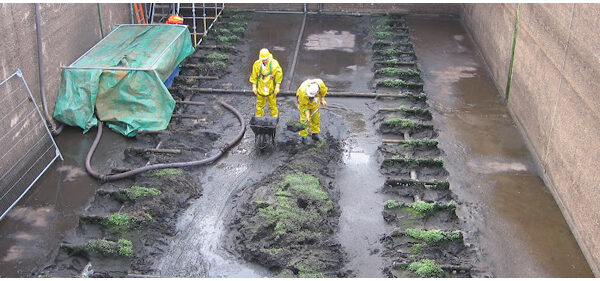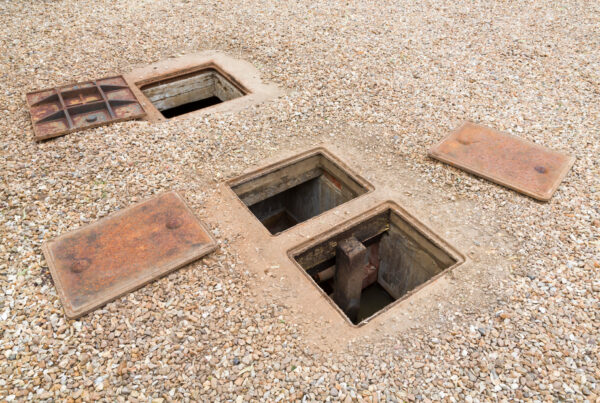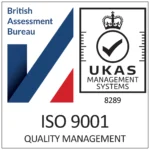What is a Septic Tank?
A septic tank is a crucial component of a home’s wastewater management system. It treats and disposes of household wastewater on-site when a connection to a central sewage system is unavailable.
Function and Importance
Septic tanks play a vital role in handling household waste. They collect wastewater from sinks, showers, and toilets. Inside the tank, solids settle at the bottom while oils and grease float to the top. Bacteria break down the solids, reducing volume and forming sludge. This process protects water quality by preventing untreated waste from entering groundwater or local streams.
Types of Septic Tanks
There are several types of septic tanks, each with unique features. Concrete septic tanks, for instance, are durable and long-lasting but heavy and may require heavy machinery for installation. Plastic septic tanks are lightweight and easier to install but may be less durable over time. Fibreglass septic tanks offer a balance of durability and ease of installation, resisting rust and corrosion. Choosing the right type depends on factors like soil type, house size, and budget constraints.
Finding Septic Tank Installation Companies Near Me
Choosing the right septic tank installation company locally ensures efficient and safe operation. We’ll explore various methods to find these companies.
Online Directories and Reviews
Online directories list local septic tank installation companies. Platforms like Yelp, Trustpilot, and Checkatrade provide user reviews. These reviews offer insights into service quality. We recommend checking multiple reviews to get a balanced view. Look for consistent feedback on aspects like punctuality, professionalism, and workmanship.
Requesting Quotes and Estimates
It’s crucial to get quotes and estimates from different companies. Request detailed breakdowns to compare costs accurately. Ensure quotes include all aspects of the installation, such as materials, labour, and any potential additional charges. We suggest contacting at least three companies. This helps identify competitive pricing and understand market rates.
Evaluating Qualifications and Experience
Qualifications and experience are vital when selecting a septic tank installer. Check for certifications from recognised bodies, such as the British Water or similar organisations. It’s beneficial to choose companies with several years of industry experience. Experience often correlates with reliability and competency. Additionally, ask for references from previous clients to assess projects’ success and customer satisfaction.
Choosing the right company involves researching online reviews, requesting quotes, and assessing qualifications and experience. This approach ensures a reliable and efficient septic tank installation.
Cost of Septic Tank Installation
Understanding the cost of septic tank installation helps in planning and budgeting efficiently. Various factors influence these costs, from the type of tank to the specifics of your location.
Factors Affecting Costs
Several elements impact the overall cost of installing a septic tank:
- Tank Type: Concrete tanks, for example, might be more expensive due to their longevity, while plastic tanks could be cheaper but potentially less durable.
- Soil Condition: Rocky or clay-heavy soil requires more preparation, increasing labour costs.
- Tank Size: Larger tanks, needed for bigger households, naturally cost more.
- Location: Proximity to a company and ease of access to your property can influence both transportation and labour costs.
- Permits and Regulations: Local regulations can necessitate specific permits or inspections, adding to the expense.
Average Installation Costs
On average, installing a septic tank costs between £3,000 and £7,000. Here’s a breakdown to give a more detailed perspective:
| Component | Average Cost (GBP) |
|---|---|
| Tank Purchase | £600 – £1,500 |
| Excavation and Labour | £1,000 – £2,500 |
| Installation Materials | £500 – £1,000 |
| Permits and Inspections | £100 – £400 |
Keep in mind these figures can vary based on the specific conditions outlined in the previous section.
Additional Expenses to Consider
Beyond the basic installation, a few additional expenses might arise:
- Maintenance Costs: Regular pumping and inspections, costing £150 to £300 per service.
- Repair Costs: Unexpected issues can lead to repairs, which vary widely in price depending on the problem.
- Upgrade Costs: Enhancing the system or meeting new regulations can incur extra costs, such as adding effluent filters or advanced treatment units.
- Landscaping: Post-installation land restoration or landscaping adjustments might be needed, adding to the overall expense.
Considering these factors ensures thorough budgeting, helping avoid unexpected financial strain. By understanding the cost implications, we can invest wisely and maintain our septic systems efficiently.
Septic Tank Installation Process
Understanding the septic tank installation process helps ensure a smooth and efficient setup. Here, we’ll break down the key stages involved.
Pre-installation Requirements
Before installing a septic tank, certain requirements must be met. First, site evaluation, assessing soil type, groundwater level, and percolation rate is crucial. Next, obtaining necessary permits from local authorities ensures compliance with regulations. We also need to choose the appropriate tank size and type based on the home’s wastewater needs.
Installation Steps
The installation process follows distinct steps. Excavate the designated area first to create space for the tank. Position and level the tank to ensure correct placement. Next, connect the inlet and outlet pipes to integrate the tank with the home’s plumbing system. Backfill the excavated area around the tank, compacting the soil in layers to avoid settling. Lastly, install the drain field or soakaway system to manage the effluent.
Post-installation Maintenance
Regular maintenance keeps the system operating efficiently. Schedule septic tank pumping every three to five years, depending on usage. Monitor the system for signs of issues, such as slow drains or unpleasant odours. Use water efficiently to avoid overloading the system, and avoid flushing non-biodegradable items. Regular inspections by professionals ensure long-term functionality.
Regulations and Permissions
Before installing a septic tank, adhering to local regulations and obtaining the necessary permissions is imperative.
Planning Permission Requirements
Planning permission is essential before installation. Local authorities mandate this to ensure the septic tank doesn’t adversely impact the environment or local infrastructure. We must check with the local council to determine specific requirements for our area. These may include restrictions on tank size, location, or proximity to water sources. Failure to secure planning permission can result in fines or mandated removal of the tank.
Environmental Regulations
Environmental regulations protect the local ecosystem, ensuring septic tanks don’t contaminate groundwater or soil. We need to follow the Environment Agency’s rules in England and SEPA guidelines in Scotland. Key considerations include maintaining proper distance from watercourses and wells, ensuring tanks are watertight to prevent leaks, and using bio-friendly materials that don’t harm soil bacteria. Compliance with these regulations not only avoids legal issues but also preserves environmental health.
By understanding and following these regulations, we can ensure a smooth, legally compliant septic tank installation.
Key Takeaways
- Understanding various types of septic tanks, such as concrete, plastic, and fibreglass, helps in selecting the right one based on durability, installation ease, and cost considerations.
- Using local online directories and reviews, alongside requesting quotes and evaluating qualifications, ensures you select a reliable and experienced septic tank installation company.
- Budgeting for septic tank installation involves considering costs for tank purchase, excavation, installation materials, permits, and potential additional expenses like maintenance, repairs, and landscaping.
- Familiarising oneself with the entire installation process, including pre-installation requirements, installation steps, and post-installation maintenance, ensures a smooth and efficient setup.
- Adhering to local planning permissions and environmental regulations is crucial to avoid legal issues and protect the local ecosystem during septic tank installation.
Conclusion
Choosing the right septic tank installation company is crucial for ensuring the efficiency and safety of our household wastewater management system. By exploring the top local companies and understanding their unique qualities, we can make informed decisions that best suit our needs.
It’s essential to consider various factors such as tank type, soil condition, and installation costs. Using online directories and reviews, obtaining multiple quotes, and evaluating qualifications will help us find a reliable installer.
Adhering to local regulations and understanding the installation process will ensure a smooth and compliant installation. With this comprehensive approach, we can confidently invest in a septic system that meets our requirements and protects our environment.
Frequently Asked Questions
Do you need planning permission to fit a septic tank?
Yes, installing a new septic tank requires planning permission from your local authority. However, if you’re only replacing an existing tank, you typically do not need additional permissions.
How much does it cost to put in a waste septic tank?
The overall cost for installing a septic tank ranges from £3,000 to £7,000. This includes the cost of the tank, labour, excavation, and necessary permits.
How much does it cost to pump a septic tank in my area?
Pumping a septic tank usually costs between £175 and £500. Prices can vary based on tank size, location, and service provider.
Can I install my own septic tank UK?
While it is possible to install your own septic tank, it is highly recommended to hire a professional contractor to ensure it’s done correctly, safely, and in compliance with legal regulations.
What can I use instead of a septic system?
Alternative systems include Drip Distribution Systems, Aerobic Treatment Units, Mound Systems, Recirculating Sand Filter Systems, Evapotranspiration Systems, Constructed Wetland Systems, and Cluster/Community Systems.
What are the main types of septic tanks?
The main types of septic tanks are concrete, plastic, and fibreglass. Each has unique features and considerations, depending on factors like soil type, house size, and budget.
How can I find reliable local septic tank installation companies?
Utilise online directories and review sites like Yelp and Trustpilot. Get quotes and estimates from multiple companies, check qualifications, and ask for references from previous clients.
What factors influence the cost of septic tank installation?
Several factors affect the cost, including tank type, soil condition, tank size, location, and necessary permits. Additional costs may include maintenance and post-installation landscaping.
What is the process for septic tank installation?
The installation process includes site evaluation, obtaining permits, selecting the correct tank size and type, excavation, tank positioning and leveling, plumbing connections, backfilling, and setting up the drain field.
Why is post-installation maintenance important for septic tanks?
Regular maintenance, such as pumping every three to five years and professional inspections, ensures long-term functionality and prevents costly repairs. Proper maintenance also ensures water efficiency and environmental protection.
Are there specific regulations for installing a septic tank?
Yes, local regulations require planning permission and adherence to environmental guidelines, like maintaining proper distances from water sources and ensuring tanks are watertight. Check with your local council for specific requirements.









